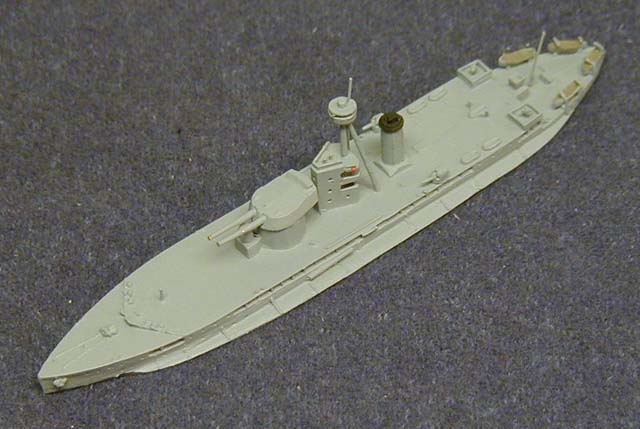H.M.S. Terror

1916
(Navis 181N)
- Class: Erebus - 2 monitors of 1916
- Displacement: 8,000 tons
- Dimensions: 380 (pp) 405 (oa) x 88 x 11 ft.
- Machinery: Triple expansion 2 screws, 7,000 shp = 12-14 knots
- Armor: Decks 1-4in, bulges
- Armament: 2-15in (1x2), 2-6in (2x1), 2-3in AA (2x1)
- Complement: 223
- Builder: Harland & Wolff, Belfast, Northern Ireland
- Launched: 18 May 1916
- Commissioned: 22 Jul 1916
- Notes: Terror and sister Erebus were built as replacements for the first 15in-gunned monitors Marshal Ney and Marshal Soult which were underpowered and far slower than anticipated. Terror received the 15in guns of the Marshal Ney with the mounting adjusted to allow 30 degree elevation for greater range. The Marshal Soult performed somewhat better and in the end was retained, so Erebus received 15in guns that had been ordered as a backup for the light battlecruiser Furious in case the latter's 18in guns proved unsatisfactory.
- Actions: Both vessels were used during WW1 to bombard the German-held Belgian coast, particularly the dockyard at Ostend. They were considered to be the most successful British monitors of WW1. In 1919 Erebus saw action against Bolshevik forces at Murmansk and later in defending newly-independent Latvia against German attacks. Between the wars both were used as gunnery trials ships at Portsmouth and as turret drill ships. In 1933 after a major refit, including a new secondary battery of eight single LA 4in guns, Terror was sent to Singapore as a guardship during the construction of the new naval base and its associated defences.
When WW2 broke out in Europe in Sep 1939, she was completing a refit at Singapore during which her LA 4in guns were replaced by six HA 4in guns and quad .50in MG replaced her 3in AA. She reached the Mediterranean in Mar 1940 and was sent in Apr to Malta to bolster the rather weak defences against anticipated Italian entry into the war, which came on 10 Jun 1940. She helped defend against Italian air raids until the Italians attacked Greece in Oct, when she was sent in Nov 1940 to help set up an advanced fleet base at Suda Bay in Crete. Returning to Alexandria in Dec, she began an intensive program of gunfire support for the British offensive against the Italians in Libya, culminating in the capture of Tobruk in Jan 1941. During a six-week period she expended more 15in ammunition than during two years in WW1, severely wearing her guns. In Feb she escorted a convoy to Benghazi where she was subjected to heavy air attacks, receiving three near misses on 22 Feb that started flooding. Attempting to return to Tobruk, she exploded two acoustic mines and then received three more near misses from German dive bombers, which caused the hull to start buckling. Attempts to tow her failed, and she finally sank on 24 Feb 20 miles northwest of Derna.
Erebus had employment against the Nazi-occupied coast in 1940, in the Indian Ocean in 1942 after Japan joined the war, in the Mediterranean, including the invasion of Sicily in 1943, and at the Normandy invasion in 1944.

 Up
Up



 Up
Up